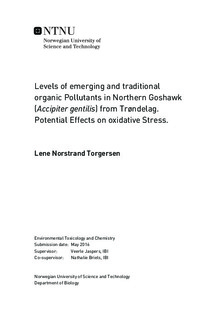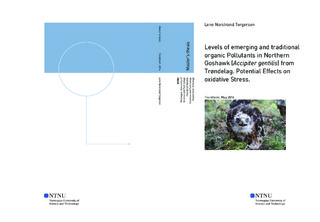| dc.description.abstract | Due to the implemented restrictions and bans of many persistent organic pollutants (POPs), the production and use of alternative chemicals are increasing. The lack of knowledge regarding the environmental occurrence, persistence and potential toxic effects of these unrestricted substitutes causes concern. In the present study, levels of legacy POPs and emerging organic contaminants, being novel brominated flame retardants (nBFRs) and organophosphate flame retardants (OPFRs), were investigated in a terrestrial, avian top predator in Norway. Nestlings of the northern goshawk (Accipiter gentilis) from 20 nests in Nord- and Sør-Trøndelag were sampled for body feathers, blood and preen oil. Contaminant levels were measured in all three non-destructive sampling matrices. It was hypothesized that contaminant levels in feathers and plasma would be positively correlated, confirming the usefulness of feathers in biomonitoring of organic pollutants. Further, to investigate the potential effect of the organic contaminants, the activity of three enzymatic antioxidants was measured in red blood cells to assess oxidative stress. It was hypothesized that increasing contaminant levels in plasma would be associated with alterations in enzyme activity. The results showed that nBFRs were generally not detected, most likely due to their low production and usage volumes. OPFRs were only detected in feathers, indicating atmospheric deposition as the source of these contaminants. Most of the targeted legacy POPs were detected in the nestlings, where sumPCBs and p,p`-DDE were the most dominant POPs (90 % of the POP load in all matrices) followed by sumPBDEs (2.4 - 4.0 % of the POP load). The sumPCBs, p,p`-DDE and sumPBDEs were positively correlated between all matrices, reflecting the connection of growing feathers with the bloodstream, as predicted. Plasma levels of CB 153 and OxC decreased with increasing nestling age, indicating growth dilution and the maternal, rather than dietary, origin of these POPs. Catalase activity increased with increasing plasma concentrations of CB 153 and OxC, suggesting that these contaminants induced oxidative stress. Overall, the present study showed that northern goshawk nestlings from Trøndelag are exposed to a wide range of legacy POPs, which currently seem to be a more prominent threat than emerging contaminants, especially since CB 153 and OxC might induce oxidative stress in the raptors. | |

